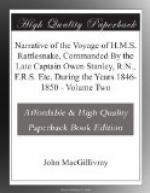September 29th.
With only another day’s supply of fresh water on board, we were glad this morning to have the islands of Pico and Fayal in sight. The view, as we closed the land, standing in from the south-westward for the roadstead of Horta, was very fine—on our left we had the beautiful island of Fayal rising to the height of 3000 feet, its sides gradually sloping towards a range of maritime cliffs, while the lower grounds, in full cultivation, indicated—along with numbers of neat white-washed cottages and occasional villages—a well peopled and fertile country, contrasting strongly with those from which we had lately returned. To the right was Pico—with the summit of its peak (stated to be 7,613 feet in height) peeping out from a mass of snowy clouds descending almost to the shore—and the centre was occupied by the more distant island of St. Jorge with a portion of Graciosa dimly seen projecting beyond its western end.
After having been for two months cooped up on board ship, I was glad to have a quiet walk on shore. In a ravine at one end of the town it was pleasing to see numbers of old acquaintances among the birds, bringing vividly to my recollection that home which we had now approached so closely. Martins were hawking about, the whitethroat warbled his short snatches of song among the bushes, and blackbirds and starlings flew past. And although engaged in the matter-of-fact occupation of searching for landshells, by turning over the stones, I could not help being struck with the beauty of the terraced walks and overhanging gardens; the beautiful belladonna lily—here run wild in great abundance—made a fine show. At Point Greta the rock pigeons—the original stock of the domesticated race—were flying about in large flocks or sunning themselves on the sea cliffs. A heavy shower of rain, by bringing out the landshells, enabled me to pick up half-a-dozen species of Helix, Bulimus, and Pupa, at the foot of the hedgerows; I was anxious to procure some to ascertain whether any were non-European forms; one was even quite a new species. On a white-flowered convolvulus with succulent leaves, I found numbers of the caterpillars of a large hawk-moth (Sphinx convolvuli) which some ragged urchins who followed me showed great dread of, running away when I picked one up and shouting to me to throw it away, else I should die. One was afterwards brought on board by an English resident—as a very venomous reptile, which had caused three or four deaths during his stay on the island. The recurved horn on the tail has been regarded as a sting, and the poor harmless creature, having once got a bad name, is now by the Fayalese, in the absence of snakes or scorpions, made to supply their place.




